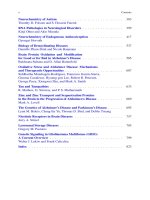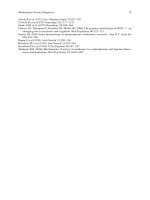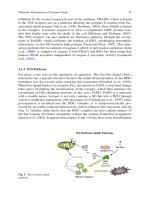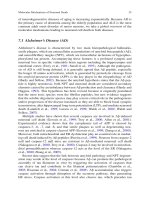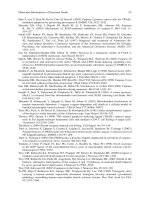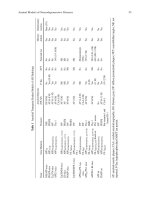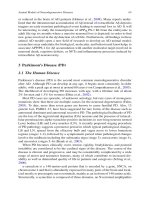Neurochemical Mechanisms in Disease P86 pps
Bạn đang xem bản rút gọn của tài liệu. Xem và tải ngay bản đầy đủ của tài liệu tại đây (300.7 KB, 10 trang )
Index 835
stereotaxic lesions, 74
systemic lesions, 74–75
Muscarinic antinociception, 424
Mutations
affecting components of NF-êB
signaling, 307
in apolipoprotein E, presenilin 1, and, 599
APP
cause dementia, 273
PS1, PS2, 411
causing neuropathies of infancy, 557
causing Pelizaeus– Merzbacher-like
disease, 554
in CMT4B2 gene, 559
in CMT4 genes, 559
in Cx32 gap junction protein, 558
disrupting, 407
ESE and ESS, 406–407
ISE and ISS, 407
in FMR1 gene, 325
in FRA11B, 326
in GFAP, 565–566
in human genome, 405
on MAPT exon 10, 411
A
n
-expansion, 347
null, 550
in periaxin gene, 558
presenilin-1 gene, 309
in PSEN2, 273
SMN1 gene, 407
splicing, see Splicing mutation
spontaneous, 347
tau gene, 278
Myelin-associated glycoprotein (MAG)
MAG gene, 554
Myelin-associated/oligodendrocyte basic
protein (MOBP), 554
Myelination, 543–544
in MAG-null mice, 557
model of PMP-22 mutation, 558
oligodendrocyte precursors, 566–567
phosphatidylinositol 3-kinase, role in, 569
Myelin basic proteins (MBP), 551–553, 570
Myelin disorders, 540, 549
Myelin lipids, 557, 561–562
Myelin-oligodendrocyte glycoprotein
(MOG), 555
Myelin proteins, 548, 551, 559, 566
proteolipid proteins, 549
structure, 542
vesicular protein, 553
Myoinositol to creatine ratio (mI/Cr), 372
Myosin light chain kinase (MLCK), 224–225
Myotonic dystrophy, 409–411
CUG repeats, 410
noncoding trinucleotide repeats, 325
type 1 (DM1), 326–327, 637
type 2 (DM2), 349
Myotubularin-related protein 2, 559
N
NADPH oxidase, 370
NAIP, see Neuronal-apoptosis-inhibitory
protein (NAIP)
N-Arachidonoyl-Dopamine (NADA), 474–475
National Institute of Neurological and
Communicative Diseases, 672
National Institute on Aging-Reagan Institute
(NIA-RI) criteria, 673
NBSCs, see Normal brain stem cells (NBSCs)
NCIs, see Neuronal cytoplasmic inclusions
(NCIs)
NE, see Norepinephrine (NE)
Necrosis, 18
Neural stem cells (NSC), 796, 804
Neuregulins (NRGs), 568
Neurodegenerative disease animal models
AD
human, 52–53
invertebrate, 62–63
perspectives, 64–65
primate, 63–64
rodent, 53–62
ALS
animal models, 77–79
human, 76–77
etiological, 51
HD
human, 79–80
invertebrate animal models, 83
primate animal models, 102
rodent animal models, 80–82
meticulous gene manipulations, 51–52
MSA
human, 73–74
primate animal models, 76
rodent animal models, 74–76
PD
human, 65–66
nonhuman primate model, 72–
73
rodent animal models, 66–72
primates use, 50–51
use and housing, 50
Neurodegenerative diseases, 203–205, 245
and apoptosis, 34
ALS, 36–38
836 Index
Neurodegenerative diseases (cont.)
Alzheimer’s disease, 35–36
Neurofibrillary lesions (NFLs), 654
Neurofibrillary tangles (NFTs), 272, 279
classical NFT, 655
ghost tangles, 655–656
pretangle stage, 654
protective role against, 279
Neuronal-apoptosis-inhibitory protein
(NAIP), 29
Neuronal cytoplasmic inclusions (NCIs), 661
Neuronal death
apoptosis, 18
necrosis, 18
programmed cell death, 18
Neuronal disconnection syndrome, 279–281
Neuronal nicotinic acetylcholine receptors
(nAChRs), 760
activation, 761–762
desensitization, 761–762
expression, diseases associated with
autism, 767
schizophrenia, 765–767
and upregulation, 761–762
Neuronal nuclear inclusions (NNIs), 661
Neuronal plasticity, 302, 304
Neuropeptides, 449
neuropeptide Y (NPY), 459–460
Neuropil threads (NThs), 654
Neuroprotection, 305, 546
Neurosteroids, 479–480
Neurotensin (NeT), 461–462
Neurotransmitters, 259, 570
Neurotransmitter sodium symporter (NSS)
family, 172
Neurotrophic factors, 462–464
Niacin
deficiency
in corn., 114–115
pellagra, 115
Parkinson’s disease, 115
NIA-RI criteria, see National Institute on
Aging-Reagan Institute (NIA-RI)
criteria
Nicastrin, 411
Nicotine, diseases nAChRs implicated by
therapeutic effects, 770
Down syndrome, 771–772
Tourette syndrome, 771
NINCDS-ADRDA, see Stroke/Alzheimer’s
Disease and Related Disorders
Association (NINCDS-ADRDA)
Nitric oxide (NO), 424, 482–484
NNIs, see Neuronal nuclear inclusions (NNIs)
Nociceptin, 454
Nocistatin, 454–455
Node of Ranvier, 543
Nogo proteins, 556
Nogo receptor-interacting protein (LRR), 556
Noladin ether, 474
Noncoding trinucleotide expansion diseases,
324
Noncoding trinucleotide repeats, 325
Noncontrast-enhanced computed tomography
(NECT), 146
Nondopaminergic signals and cognition
in PD, 265
cholinergic mechanisms, 266–267
GABA and subthalamic nucleus, 265–266
Nonpeptide molecules, 440
Nonproline-directed protein kinases
(NPDPKs), 643
Nonsense-associated skipping of remote exon
(NASRE), 408–409, 409
Nonsense-mediated mRNA decay (NMD),
408–409
Norepinephrine (NE), 426–427
Norepinephrine transporter (NET), 171
Normal brain stem cells (NBSCs), 806
NPDPKs, see Nonproline-directed protein
kinases (NPDPKs)
NSC, see Neural stem cells (NSC)
Nuclear factor
κB(NF-κB), 298
activators and inhibitors in CNS, 303
in Alzheimer disease (AD), 308–309
biological role of, 299–301
in brain diseases, 307
domains, 298
in glial cells, 306
in Huntington’s disease (HD), 309–310
inhibitors, 297
in ischemic and traumatic brain injury,
307–308
in learning and memory, 305
in multiple sclerosis, 310
in neuroprotection, 305–306
NF-κB/IκB complex, 297
in Parkinson’s disease (PD), 309
pathway
of NF-κB activation, 302–303
as potential therapeutic target, 311
regulating genes in CNS, 304
in seizures, 308
signaling in CNS, role of, 303
activators, 303
inhibitors, 303
Index 837
signaling regulation, 301–303
structure, 297
in synaptic transmission, 304–305
Nuclear tau protein, 641
Nucleotide-expansion diseases, 349
Nucleotides, 439–440
O
Occludin, 130
Oculocerebrorenal syndrome of Lowe (OCRL)
gene responsible for, 230
growth factor stimulation, 230
Rac activation, 230
Oculopharyngeal muscular dystrophy
(OPMD), 347
6-OHDA model, PD
behavioural impairment following
6-OHDA lesions
advantage, 68
motor tests, 67–68
DAT and NET, 66
medial forebrain bundle injection
(MFB), 67
striatal injection, 67
substantia nigra injection, 67
Oleamide, 469, 476–477
N-Oleoyl-dopamine (OLDA), 476–477
N-Oleoyl-ethanolamide (OEA), 476–477
N-Oleyl-dopamine (OLDA), 469
Oligodendrocyte-myelin glycoprotein
(OMgp), 560
Oligodendrocyte precursors, 566–567
Oligodendrocytes, 566, 569
Oligodendrocyte-specific protein, 553
Oligophrenin-1 (OPHN1) protein
endophilin A1 and Rho GTPases,
interactions with, 224
knock-down of, 222–223
localization and function in excitatory
synapses, 224
OPHN1 mutations, 222
signaling, 224
in tissues, 222
Olivopontocerebellar atrophy (OPCA), 660
OMgp mutants,
560
OPCA, see Olivopontocerebellar atrophy
(OPCA)
Opioid receptor-like (ORL1) receptors, 449
Opioid-related peptides, 449–450
Orexins, 448–449
Ouabain, 440–441
Oxidative stress, 343–344, 609–610
during aging, 615
and brain edema
endothelial cell incubation, ROS,
139–140
gp
91phox
(Nox2), NADPH oxidase, 140
hyperglycemia, 140
nitric oxide (NO), 141
reactive oxygen species (ROS), 139
scavenging O
2
radicals, 140
energy utilization, 616
fibrillary aggregates and
neurodegeneration, role in, 612
and metabolism
AD progression, 615
iron homeostasis, 615
metals
iron and copper, 617
from redox-active metals, 617
and mitochondria, 616
apoptotic pathways, 617
cytochrome oxidases and mtDNA, 617
nitrogen species (RNS), 615
reactive oxygen species (ROS), 615
Oxytocin (OT), 391–392, 441–442
P
p21-Activated kinase 3 (PAK3)
actin filament depolymerizing/severing
factor, 224
and/or synaptic plasticity, 225
CREB protein levels, 226
dendritic spine morphogenesis regulation,
225
expression, 227
mediated cytoskeletal signaling, 224
nonsyndromic X-linked MR, 224
PAK3 mutations, 224
phosphorylation and activation of LIMK,
224
R421X and A367E mutations, 225
stress fibers triggered by, 224–225
synapse formation, 225
Pain
ATP, facilitatory role, 440
control, 444
GABA and receptors in, 434
hemorphins, role in, 453
models, 422, 439, 442, 446
inflammatory, 463
neuropathic, 463
modulation, 435, 480
nitroglycerin inducing, 483
pathophysiology of, 486
regulation, 451
838 Index
Pain (cont.)
serotoninergicic modulatory pathways, 423
syndrome, 434, 460, 482
threshold, 429, 430, 432, 435–436, 442,
449, 456, 467, 477
transmission, 447, 461
N-Palmitoyl-glycine (PalGly), 469, 475–476
Palmityl ethanolamide (PEA), 468, 475–476
Paraneoplastic neurological disorders
(PND), 413
Paranode, 543
Parkinson disease (PD), 185, 245
ATP13A2
gene function and expression, 730
gene location and structure, 730
genetic variation, 730–731
inheritance and clinical features,
729–730
structure and mutations, 731
clinical diagnostic, 714
clinical manifestations, 713
cognitive ERP-S in, 259
delayed-response tests, 258
DJ1
gene function and expression, 726–727
gene location and structure, 726
genetic variation, 727
inheritance and clinical features, 726
structure and mutations, 728
etiology of, 248
fontostriatal circuits, 252–253
GBA
gene function and expression, 732
gene location and structure, 732
genetic variation, 732–733
inheritance and clinical features,
731–732
structure and mutations, 733
HTRA2
gene function and expression, 722–723
gene location and structure, 722
genetic variation, 723
inheritance and clinical features, 722
structure and mutations, 722
human disease
description, 65
monogenic mutations, 65
α-synuclein, 65–66
idiopathic, 248
impaired memory, 253–255
LRRK2
gene function and expression, 718–719
gene location and structure, 718
genetic variation, 719
inheritance and clinical features,
717–718
structure and mutations, 719
molecular progression, 248
neurobiology of, 248
neuropathological diagnosis
Lewy bodies (LBs), 714
nonhuman primate models
MPTP, 72–73
α-synuclein gene, 73
pathological process of, 247
PINK1
gene function and expression, 728–729
gene location and structure, 728
genetic variation, 729
inheritance and clinical features, 728
phosphatase and tensin (PTEN), 728
structure and mutations, 730
prevalence and incidence, 713
PRKN
exonic deletions in, 725
gene function and expression, 724
gene location and structure, 723
genetic variation, 724
–726
inheritance and clinical features, 723
structure, 725
retinopathy, 247
rodent animal models
genetic rodent, 69–72
MPTP, 68–69
6-OHDA, 66–68
SNCA
gene function and expression, 716–717
gene location and structure, 716
genetic variation, 717
inheritance and clinical features,
715–716
structure and mutations, 715
spatial orientation in, 256–257
striatal GABAergic output pathways, 252
as synucleinopathy, 248–249
UCHL1
gene function and expression, 720
gene location and structure, 720
genetic variation, 721
inheritance and clinical features,
719–720
postmortmem studies, 720
structure and mutations, 720
Partington syndrome (PRTS), 347
Pathogen-associated molecular patterns
(PAMPs), 363
Index 839
PCD, see Programmed cell death (PCD)
PDPK, see Proline-directed protein kinases
(PDPK)
Pedunculopomtine nucleus (PPN), 265–266
Pelizaeus–Merzbacher disease (PMD), 551
Peptides, 441
hormones, 441
Peptidyl arginine–deiminase (PAD), 553
Perfusion computed tomography (PCT),
146–147
Peripheral myelin protein 22 (PMP22),
557–558
Phospholipids, 565
PIDDosome
caspase-2, 22
PIDD, 22
RAIDD, 22
Pituitary adenylate cyclase-activating
polypeptide-38 (PACAP-38),
457–458
p38 kinases, 368
“Plague of Athens,” 4
Platelet endothelial cell adhesion molecule-1
(PECAM-1), 131
p38 mitogen-activated protein kinase
(MAPK), 176
PNFA, see Progressive nonfluent aphasia
(PNFA)
PNS myelin proteins, 557–559
Polyalanine (A
n
)-expansion diseases, 324,
346–347
mechanisms contributing to, 348–349
and Q
n
-expansion diseases, 347–348
Polymorphisms, 256, 387
Polypyrimidine tract binding protein (PTB),
407
Polypyrimidine tract (PPT), 403
Potassium channels, 470
PPA, see Primary progressive aphasia (PPA)
PPP2R2B gene, 330
Prader–Willi Syndrome (PWS), 412
Pravastatin trial, 618–619
Presenilin
presenilin enhancer 2 (PEN-2), 411
presenilin 1 (PS1) and 2 (PS2)
mutations, 673
presenilin 1 (PS1) genes, 276, 411
presenilin 2 (PS2) genes, 276, 411
Primary demyelination, 545
Primary progressive aphasia (PPA), 649–650
Primate models, AD
lesioning approaches
behavioural and cognitive effects, 64
forebrain cholinergic neurons,
neurotoxin, 63–64
pharmacological approaches
cholincholinergic neurotransmission,
64
drugs, preclinical, 64
spontaneous approaches
cognitive function, 63
nonhuman primates, 63
Progesterone, 480–481
Programmed cell death (PCD), 18
Progressive nonfluent aphasia (PNFA), 650
Progressive supranuclear palsy
clinical features
duration of illness, 658
onset of symptoms, 658
neurochemistry and neurobiology, 658–659
neuropathology, 658
Proinflammatory cytokines, 363
Prolactin, 447–448, 572
Proline-directed protein kinases (PDPK), 643
Pro-opiomelanocortin (POMC), 364
POMC1 gene expression, 374
Protein oxidation, in AD
in AD pathogenesis, early or late event,
598–599
protein carbonyls, 590–592
protein nitration, 592–598
Protein zero (P0), 557
Psychoses
classification, 10
DISC1 locus, 10
neuroregulin 1 gene (NRG-1) mutations in,
10–11
recognizing
DSM IV-TR, 9
Psychostimulant addiction
baclofen, 181
cocaine, 180
DAT, 181
GABAergic system, 180
neurotransmitter systems modification,
180–181
serotonin reuptake inhibitor (SSRI)
fluoxetine, 181
TCA desipramine, 181
VMAT2, dopamine levels, 180
Purkinje cell bodies, 336
Pyridoxine
central nervous system, 110
deficiency
dendritic arborisation, 111
melatonin, 111
840 Index
Pyridoxine (cont.)
in pregnant rats, 111–112
putrescine, 111
in rats, 111
tryptophan conversion, 112
use, 110
Pyrin domains (PYDS), 366
Pyruvate dehydrogenase complex, 106–107
Q
Q
n
-expansion diseases, 330–332, 336–341,
348
factors contributing to neurodegeneration,
337
axonal transport, defects in, 344
caspase activity, 342–343
excitotoxicity/oxidative stress, 343–344
gene expression, interference with,
340–341
integration of mechanisms, 344–346
mitochondrial function, interference
with, 341–342
proteasome function, disrupted,
339–340
toxic protein aggregates, 337–338
therapeutic strategies, 346
Quaking viable (qkv) mutation, 569
R
RAIDD, see RIP-associated ICH-1/CED-3
homologous protein with death
domain (RAIDD)
Reactive nitrogen species (RNS), 364, 590
Reactive oxygen species (ROS), 364
Receptor-interacting kinase-1 (RIP1), 24
Reelin, 392
Rel family, 297
polypeptides, 301
Remyelination, in MS, 545
Renin-angiotensin system (RAS), 444
Retina, 250, 260
dopamine in visual processing, 260–262
foveal retinal ganglion, antagonistic
center and, 262
OCT image, 261
pattern ERG PERG in, 261
dopaminergic dysfunction, model of,
262–264
ganglion cells, 250, 252
Rett syndrome, 412
RFamide neuropeptides, 460–461
Rho GTPases
CYFIP/Rac/PAK and fragile X syndrome,
228–229
effector pathways, 223
mental-disorder-associated GAP
(MEGAP), 231–232
mental retardation proteins, 223
oculocerebrorenal syndrome of Lowe
protein 1 (OCRL1), 230–231
oligophrenin-1 (OPHN1), 222–224
p21-activated kinase 3 (PAK3), 224–227
regulators and effectors, mutations in, 221
Rho guanine nucleotide exchange factor 6
(ARHGEF6), 227–228
synaptic structure and function
AMPAR activity-dependent structural
plasticity, 220
CaMKII activation, 219
Cdc42, role in, 221
EphB receptor, 221
mEPSCs, 219
myosin–actin interactions, 220
myosin light chain (MLC), 220
NMDAR-dependent spine development,
219
Rac-GEF Tiam1, 219
Rac transforms, 219
regulatory cycle, 218
Rho kinase, 220
WAVE proteins, 220
Rho guanine nucleotide exchange factor 6
(ARHGEF6)
ARHGEF6 gene mutation, 227
nonsyndromic X-linked MR, 227
RNAi-mediated knock-down of, 227–228
spine morphogenesis regulation, 228
RIP-associated ICH-1/CED-3 homologous
protein with death domain
(RAIDD), 22
Rivastigmine treatment for AD, 618
Rostroventral medulla (RVM), 421
Ryanodine receptor (RyanR), 334
S
SAPK family, see Stress-activated protein
kinase (SAPK) family
Schizophrenia, 255
Chrna7, 766–767
evidence, 765–766
GABAergic system in, 767
Schwann cell, 540
, 543–544, 546, 555, 558,
571
Science and clinical medicine, contrasts
between, 2–3
Second mitochondria-derived activator of
caspases (Smac), 31
Index 841
β-andγ-Secretase inhibitors, 618–619
Seizure, 273, 308, 335, 391, 412
Selective serotonin reuptake inhibitors
(SSRIs), 387
Semantic dementia (SD), 650
Senile plaques, 673
Serotonin, 386–387, 428–429
Serotonin transporter (SERT), 171
Serotonin transporters (5-HTT), 387
Serum amyloid P component (SAP), 811
Sexual hormones, 480–482
Short-term memory, 256
Shy–Drager syndrome (SDS), 660
Smac, see Second mitochondria-derived
activator of caspases (Smac)
Smooth muscle actin (SMA), 132
SND, see Striatonigral degeneration (SND)
Somatostatin (SST), 447
Sphingoglycolipids, 561
Spinal dorsal horn (SDH), 421
Spinal muscular atrophy (SMA), 407–408
Spinobulbar muscular atrophy (SBMA), 332
Spinocerebellar ataxia
type 1 (SCA1), 333–334, 350
type 2 (SCA 2), 334
type 3 (SCA 3), 334–335
type 6 (SCA 6), 335–336
type 7 (SCA7), 336
type 8 (SCA8), 328, 330, 413
type 10 (SCA 10), 349
type 12 (SCA12), 330
type 17 (SCA17), 336–
337
Spinorphin, 454
Splicing cis-elements disruption
disorders associated with, 404
branch point sequence (BPS) in
humans, 405–406
ectopic AG dinucleotide, 406
mutations, 406–407
spinal muscular atrophy (SMA),
407–408
5
splice sites, aberrations of, 404–405
Splicing mechanisms, physiology, 403–404
Splicing mutation, 408
skipping of multiple exons, 408
CHRNE exon, 408–409
contiguous exons, 408
remote exon, 408–409
SRT, see Substrate reduction therapy (SRT)
Steroids, 479
STN–GPi pathway, 265
Stress-activated protein kinase (SAPK)
family, 614
Stress-induced analgesia (SIA), 420
Stress kinases, 368–370
signal transduction pathways, 369
Striatonigral degeneration (SND), 660
Striatum, 267–268, 341, 343
Stroke/Alzheimer’s Disease and Related
Disorders Association (NINCDS-
ADRDA), 672
Substrate reduction therapy (SRT), 796
Subthalamic nucleus (STN), 254
Sulfogalactosylceramide, 563
Survivin, 29
Susceptibility-weighted imaging (SWI), 150
Sydenham’s conceptualization
of specific diseases, 4
bacteriology and virology, 5–6
chemical and biological refinements, 5
Synaptic dysfunction in AD, 279
Synaptopodin, 279
Synuclein, 245
T
Tachykinins, 455–456
Tacrine treatment for AD, 618
Tandem repeat (VNTR) polymorphisms, 256
Tau protein
acid- and heat-stable protein, 638
aggregation of, 614, 639
axonal morphology and polarity, 614
cell morphology, 639
CNS astrocytes and oligodendrocytes, 639
3D crystal lattices, 639
as diagnostic marker, 661–662
expression, disturbances in, 639
function of, 614
microtubule organization, 639
modifications
deamidation, 647
glycosylation, 646
oxidation, 647
prolyl isomerization, 647
truncation, 647
ubiquitnylation, 647
for neuronal formation and health, 639
phosphorylation
and AD, 614–615
altered intracellular trafficking/polarity,
644, 646
altered proteolysis, 646
axonal transport, 646
microtubule binding, 644
physiological and pathological
functions, 645
842 Index
Tau protein (cont.)
physiological role of, 643–644
protein kinases, role in, 643
protein phosphatase, 643
sites, 642
posttranslational modifications of, 641–646
predictable secondary structure, 641
3R-tau and 4R-tau isoforms, 637
domains, 640
and SAPK family, 614
Ser-Pro and Thr-Pro motifs, 614
within somatodentritic compartment of
neurons, 641
structure study, 639
in synaptic dysfunction, 281
tau gene, 279
interactions with microtubules, 637
intronic mutations, 637
missense mutations, 637
mutations, 636
representation, 638
tauopathies
Alzheimer disease (AD), 651–658
corticobasalganglionic degeneration,
659–660
frontotemporal dementia (FTD),
649–651
immunohistochemical studies, 648–649
multiple system atrophy (MSA),
660–661
neurodegenerative disorders with, 649
phosphorylation and, 636
progressive supranuclear palsy,
658–659
tau transgenic mouse models, 61
as therapeutic target, 662
turnover of, 647
PEST sequence, 648
ubiquitin-independent proteosomal
degradation, 648
Taurine, 436–437
Tay–Sachs disease, 6
clinical patterns, 7
clinical phenotype, variations in, 8
enzymatic studies, 7
genetic variability
HEXA gene, 7–8
molecular genetic studies, 7
neurochemical studies, 7
neuropathological observations, 7
“pseudosulfatase deficiency,” 9
Tetraspanin 2, 554
Thalamocortical circuitry, 253–255
Thalamocortical processing, 267
Theory of humors, 4
Thiamine
and cell metabolism/function
enzyme cofactor, 106–108
neural membrane compound, 108
deficiency, 104
deficiency-related neurological disorders
Alzheimer disease (AD), 105
Korsakoff’s psychosis, 105
oxythiamine, pyrithiamine and
amprolium, 105–106
WE, 105
description, 104
neuronal cell death, deficiency
blood-brain barrier disruption, 109–110
cellular energy failure, 108
NMDA receptor-mediated excitotoxic-
ity, 109
oxidative/nitrosative stress, 109
status, diet and factors, 104
structure, 104
Thyrotropin-releasing hormone (TRH),
446–447
Tight junction proteins
claudins, 130
occludin, 130
paracellular permeability, 131
zona occludens, 131
TNF receptor-associated factor 2 (TRAF2), 24
TNFRSF1A-associated via death domain
(TRADD), 23–24
α-Tocopherol (vitamin E)
brain function and neurodegeneration, 117
chronic deficiency, 116–117
description, 116
retention and secretion, 117
supplementation, 117
Tolcapone, 255
Toll-like receptors (TLRs),
363
Tourette syndrome, 771
Toxic protein aggregates, 337–339
TRADD, see TNFRSF1A-associated via death
domain (TRADD)
Transcription factors, 341, 348, 376, 568–569
Transferrin (Tf), 570
Transforming Growth Factor-Beta (TGF-β),
366–367
Transgenic mouse models, AD
APP
amyloid plaques, 54–55
CAA, 54
cDNA, 54
Index 843
mutation, β and γ-secretase site, 53–54
TgCRND8, 54
Thy-1.2, 54
APP/ADAM, 58
APP/ApoE
amyloid and tau pathology, 57
Aβ42 and Aβ40, 57–58
synap synaptophysin and MAP 2
staining, 57
APP/BACE, 57
APP/PS-1
APP
SL
/PS-1 knock-in, 56
double, 54, 56
FAD, 54
microglial activation and astrocyte
reactivity, 56–57
tau and tau/APP
cdk-5, p35 and tau-4R, 60
FTD and FTDP-17, 58–59
isoforms, 59
Parkinsonism, 58
phosphorylate, kinase, 59–60
synthetic Aβ42, NFT numbers, 59
Transient receptor potential melastatin 8
(TRPM8) receptor, 471
Translation factors (eIF4E), 369
Tricarboxylic acid (TCA) cycle, 196
Trinucleotide expansions
disease, 324
in genome, 324
Trinucleotide repeats, 324
TRPV1 receptors, 470, 472
Tryptophan hydroxylase (TPH1), 387
T-type calcium channels, 471
Tumor necrosis factor (TNF) pathway, 23–25
See also Extrinsic/receptor-mediated
pathway
Tyr-MIF Peptides, 453
U
Ubiquitin–proteasome system (UPS), 648
UDP-Galactose, 557
Umbilical cord blood (UCB), 796
Unmyelinated C-fiber activation, 421
V
Variable number tandem repeat (VNTR)
DAT, 178–179
SERT, 179
Vascular endothelial growth factor
(VEGF), 811
and angiopoietins, 142–143
and neovascularization (NV), 812
vasogenic edema in gliomas, 812
Vasoactive intestinal peptide (VIP), 458
Vasoactive intestinal polypeptide (VIPergic)
neurons, 248
Vasogenic brain edema
cell damage lack, 133
extracellular space expansion, 133
formation, MMPs role
basal lamina components
degradation, 138
BBB permeability, 138
cerebral ischemia, 139
matrix metalloproteinases, 138
multiple sclerosis, and CNS infections,
138
occludin, claudin-5, and ZO-1, 138–139
pharmacological blockade, 139
plasminogen/plasmin system, 139
proteases, lactate and acidosis, 138
white matter fiber tracts, 133–134
Vasopressin, 442
Ventro-posterior-lateral (VPL) thalamic
nucleus, 112
Verbal fluency test scores, 258
Very long chain fatty acids (VLCFA), 564
Vesicular glutamate transporter
(VGLUT2), 205
Vesicular monoamine transporters
(VMAT), 175
VGLUT2, see Vesicular glutamate transporter
(VGLUT2)
Virodhamine, 468
Virology, 5–6
Vision and visual cognition
aging and cognitive event related
potentials, 259
neurotransmitters and cognitive ERP-S in
PD, 259–260
short-term memory for visual stimuli and
spatial orientation in PD, 256–258
Visual cognition, 256
Visual perceptual categorization, 258
Visual stimuli, 256
Vitamin B1, see Thiamine
Vitamin B3, see Niacin
Vitamin B6, see Pyridoxine
Vitamin B9, see Folic acid
Vitamin B12
cofactor and inhibition, enzyme
reaction, 113
cytokine production, myelinolytic
TNF-α, 114
deficiency, 113
844 Index
Vitamin B12 (cont.)
methylcobalamin/adenosyl-cobalamin,
112–113
methyl trap hypothesis, 114
Vitamin B complex, 104
Vitamins and vitamin deficiencies
antioxidant
ascorbic acid (vitamin C), 118–120
α-tocopherol (vitamin E), 116–118
carotenoids, 120
cobalamin (vitamin B12)
cofactor and inhibition, enzyme
reaction, 113
cytokine production, myelinolytic
TNF-α, 114
deficiency, 113
methylcobalamin/adenosyl-cobalamin,
112–113
methyl trap hypothesis, 114
folic acid (vitamin B9)
deficiency, 115–116
niacin (vitamin B3)
black tongue, corn-fed dogs, 114
neurological symptoms, 114–115
pellagra, 115
zein, 114
pyridoxine (vitamin B6)
deficiency, 111–112
dendritic arborisation, deficiency, 111
hypothalamus, 111
melatonin, 111
pathology, central nervous system, 110
roles, 110–111
tryptophan conversion, 112
use, 110
thiamine (vitaminB1)
and cell metabolism/function, 106–108
deficiency, 104
deficiency-related neurological
disorders, 105–106
description, 104
neuronal cell death, deficiency,
108–110
status, diet and factors, 104
structure,
104
treatment for AD, 620
W
Washington Heights–Inwood Columbia Aging
Project, 620
Wernicke’s encephalopathy (WE), 105, 110
West syndrome (WS), 347
Wisconsin card sorting test (WCST), 257
X
X-linked demyelinating neuropathy, 558
Y
YB-1, splicing trans-factor, 413
Yeast artificial chromosomes (YAC), 82
Z
Zellweger syndrome, 565
Zinc and zinc homeostasis
assembly and disassembly of tubulin, 676
blood/brain and blood/cerebrospinal fluid
(CSF) barriers, 674
maintenance
by metallothioneins (MT), 676–677
by zinc transporter (ZnT) proteins, 676,
678–679
by Zrt–Irt-like (ZIP) proteins, 676–678
mediated dysfunction in oxidative
phosphorylation, 676
NMDA receptor channels, 676
plasma transport, 674
protein kinase C (PKC) signaling
pathways, 674
role in pathogenesis of AD, 679
association with SP, 680
Aβ deposition, 682–683
in brain, 681
cellular localization, 680
CSF Zn levels, 681
Mini Mental Status Examination
scores, 680
senile plaques study, 680
Western blot analysis, 681
as therapeutic target in AD, 683–684
transport and sequestration
brain Zn concentrations, 675
cytoplasmic pool, 675
membrane-bound metalloprotein, 675
protein–metal complex pool, 675
vesicular pool, 675
zinc transporter (ZnT) family, 674
Zrt-Irt (ZIP) family,
674
Zinc transport (ZnT) proteins
cation diffusion facilitator family, 678
L-type calcium channels (LTCC), 678
metal response element (MRE)
in genes, 678
ZnT-1 expression, 678
ZnT-2, ZnT-3 and ZnT-4 expression, 679
Zrt–Irt-like (ZIP) proteins
histidine-rich intracellular loop, 677
ZIP-1 mRNA, 677
ZIP-5, ZIP-6 and ZIP-7, 678
ZIP-2, ZIP-3 and ZIP-4 expression, 677


